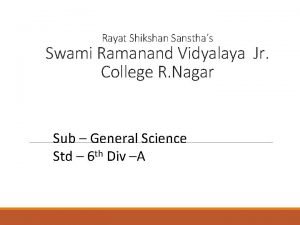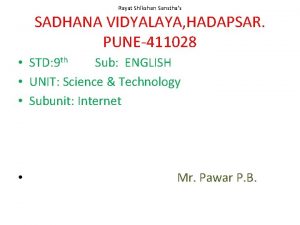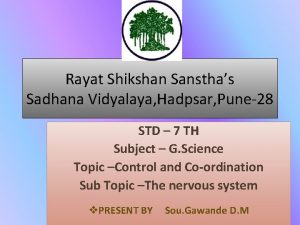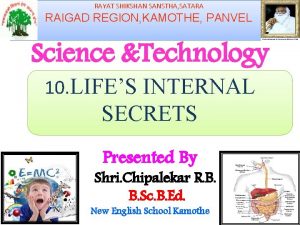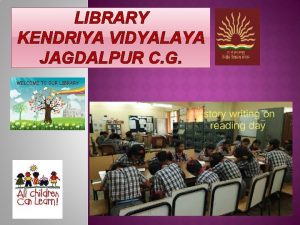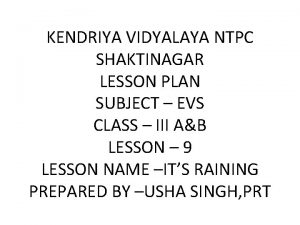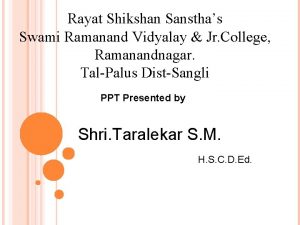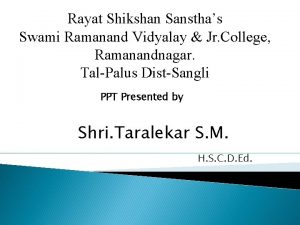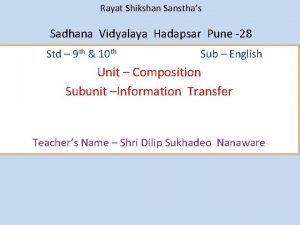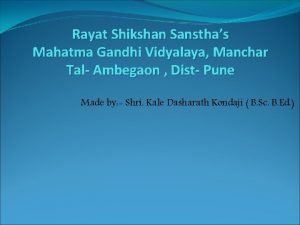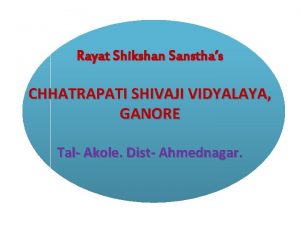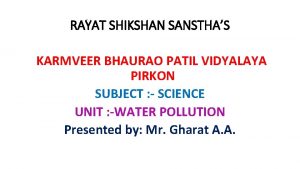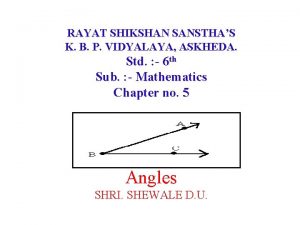Rayat Shikshan Sansthas Swami Ramanand Vidyalaya Jr College





























- Slides: 29

Rayat Shikshan Sanstha’s Swami Ramanand Vidyalaya Jr. College R. Nagar Sub – General Science Std – 6 th Div –A

Smt. Thorat S. N.

ORGAN SYSTEM A group of organs working together to carry out a common bodily function is called an organ system.

v. The digestive system. The group of organs working together to carry out common body function is called the digestive system.

Organs of the Alimentary Canal · Mouth · Pharynx · Esophagus · Stomach · Small intestine · Large intestine · Anus

Mouth · Lips · Teeth · Tongue

Stomach · Located on the left side of the abdominal cavity · Food enters at the cardioesophageal sphincter Slide

Stomach

Stomach Functions · Acts as a storage tank for food · Site of food breakdown · Chemical breakdown of protein begins · Delivers chyme (processed food) to the small intestine

Chemical Digestion in the Small Intestine Figure 14. 6

Large Intestine · Larger in diameter, but shorter than the small intestine · Frames the internal abdomen

Large Intestine

Functions of the Large Intestine · Absorption of water · Eliminates indigestible food from the body as feces · Does not participate in digestion of food · Goblet cells produce mucus to act as a lubricant

Question Hour. Q 1) Name some organ systems in the human body. Ans- Respiration, Digestion, Circulation, Q 2) Where are salivary glands located? Ans- Salivary glands located near throat and the ears

Respiratory system • Inhalation – Taking oxygen from the air inside the body. • Exhalation – To leaving out carbon dioxide from the body. • Breathing - Inhalation and exhalation togetherly called Breathing. *The nose, trachea, lungs, diaphragm the rib-cage are the parts of Respiratory system.

The Respiratory System MB


The Nose and Mouth This is where it all begins. This is where the oxygen first enters your body and also where Carbon Dioxide leaves.

The Nose and Mouth When the air comes into your nose it gets filtered by tiny hairs and it is moistened by the mucus that is in your nose. Your sinuses also help out with your Respiratory System. They help to moisten and heat the air that you breath. Air can also get into your body through your mouth/oral cavity but air is not filtered as much when it enters in through your mouth.

Nose and Mouth Picture Here is a picture of your nasal and oral cavity.

The Pharynx and Trachea Next we will head down to your pharynx (throat) and your trachea (windpipe). This is where the air passes from your nose to your bronchi tubes and lungs.

Alveoli and Bronchi Picture Trachea Bronchi Tubes Bronchiole Alveoli

The Alveoli and Capillary Network Now we will head over to the alveoli and what happens when the air finally makes it down there.

Alveoli Picture

Respiratory Bronchiole uso elv. Al Alveolar Duct Alveolar Sac Capillaries Bronchiole

seurtcpi. Col

Diagram of Diaphragm

CO 2 Air Passing over the mucus membrane of the nasal cavity is moistened, warmed, and filtered Inside the lungs the Bronchi branch into small tubes called bronchioles The Pharynx, or throat, is located where passages from the nose and mouth came together. Respiratory Overview Review At the end of the bronchioles are bunches of alveoli, air sacs, arranged like grapes on a stem If one lobe is injured or diseased, the other lobes may be able to function normally JH The trachea divides into two tubes called bronchi Air enters the trachea, or wind pipe which leads to and from the lungs

THANK YOU
 Swami ramanand vidyalaya ramanandnagar
Swami ramanand vidyalaya ramanandnagar Swami ramanand vidyalaya ramanandnagar
Swami ramanand vidyalaya ramanandnagar Rayat shikshan sanstha sadhana vidyalaya hadapsar
Rayat shikshan sanstha sadhana vidyalaya hadapsar Sadhana vidyalaya hadapsar pune 28
Sadhana vidyalaya hadapsar pune 28 Rayat shikshan sanstha sadhana vidyalaya hadapsar
Rayat shikshan sanstha sadhana vidyalaya hadapsar Rayat shikshan sanstha kamothe
Rayat shikshan sanstha kamothe Rayat shikshan sanstha motto
Rayat shikshan sanstha motto Rayat shikshan sanstha loni
Rayat shikshan sanstha loni Rayat shikshan sanstha motto
Rayat shikshan sanstha motto Rayat shikshan sanstha motto
Rayat shikshan sanstha motto Rose rayat shikshan sanstha
Rose rayat shikshan sanstha Swami ishwarananda
Swami ishwarananda Swami vivekananda and tesla
Swami vivekananda and tesla Swami chart
Swami chart Swami vivekanand institute of technology and management
Swami vivekanand institute of technology and management Prarthana dham
Prarthana dham Swami vivekananda ap world history
Swami vivekananda ap world history उद्दीपकाचे
उद्दीपकाचे Maharaja sawai man singh vidyalaya
Maharaja sawai man singh vidyalaya Kendriya vidyalaya bhu varanasi
Kendriya vidyalaya bhu varanasi Maharaja sawai man singh vidyalaya
Maharaja sawai man singh vidyalaya Chhatrapati shivaji vidyalaya
Chhatrapati shivaji vidyalaya Swachha vidyalaya puraskar.com
Swachha vidyalaya puraskar.com Kvs jagdalpur
Kvs jagdalpur Objectives of kgbv
Objectives of kgbv Kendriya vidyalaya annual pedagogical plan
Kendriya vidyalaya annual pedagogical plan Sant tukaram vidyalaya dehu
Sant tukaram vidyalaya dehu Kvs bangalore region lesson plan
Kvs bangalore region lesson plan Nirmal vidyalaya abhiyan report
Nirmal vidyalaya abhiyan report Shri bhairavdev vidyalaya
Shri bhairavdev vidyalaya
